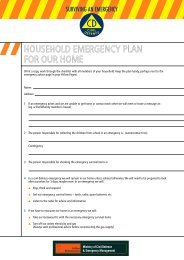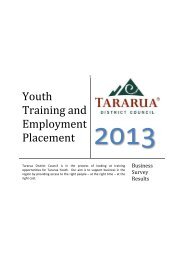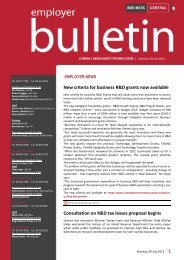Food Control Plan Checklist - Tararua District Council
Food Control Plan Checklist - Tararua District Council
Food Control Plan Checklist - Tararua District Council
- No tags were found...
Create successful ePaper yourself
Turn your PDF publications into a flip-book with our unique Google optimized e-Paper software.
ManagementDocumentation and record keepingMaking changesSignificant changes to the off-the-peg <strong>Food</strong> <strong>Control</strong> <strong>Plan</strong> are likely to require evaluation and approval by the registration authoritybefore being incorporated into the plan.Examples of changes that are likely to require evaluation include:• adding new processes that are not covered by the procedures• providing meals to people other than general consumers (eg, catering for a hospice)Changes that are not likely to require evaluation or approval from the registration authority include:• using your own record sheets as long as they contain at least the same information as those provided in the off-the-peg <strong>Food</strong><strong>Control</strong> <strong>Plan</strong>• changing the order of the sections• removing or marking as ‘not applicable’ parts of the off-the-peg <strong>Food</strong> <strong>Control</strong> <strong>Plan</strong> that do not apply to your business(eg, removing Transporting <strong>Food</strong> if you do not transport food, or Display and self-service if food is cooked to order). If you do thisremember to update the contents page.If you’re unsure whether a proposed change may require evaluation contact your registration authority for advice.Record keepingCompleting the Diary is an important part of record keeping. The Diary is used to:• write down anything that goes wrong• write down what was done to correct the problem and to prevent customers being affected• write down what was done to prevent it from happening again• confirm that the procedures in the <strong>Food</strong> <strong>Control</strong> <strong>Plan</strong> have been followed.The Diary also includes forms for recording:• daily chilled food temperature checks• weekly poultry temperature checks• thermometer calibrations• your cleaning schedule• your maintenance scheduleSee the section Using the Diary in the <strong>Food</strong> <strong>Control</strong> <strong>Plan</strong> Diary.Other important record keeping documents include: (see Records section of the <strong>Food</strong> <strong>Control</strong> <strong>Plan</strong>)• 2hr hot-held food records• Poultry time/temperature settings• Cooking poultry temperature records• Approved suppliers• Sickness records• Staff training records• Pest control (contractor records)Document controlWhen making changes to any part of the <strong>Food</strong> <strong>Control</strong> <strong>Plan</strong> make sure that the page that has been changed is updated with thedate the change was made and a new version number.When changes are made to any of the information in the <strong>Food</strong> <strong>Control</strong> <strong>Plan</strong> the contents page at the front of the <strong>Food</strong> <strong>Control</strong> <strong>Plan</strong>must also be updated with the new version number.Older versions that have been replaced must be kept for four years.All documents including procedures that are no longer used, and monitoring records will be kept for at least four yearsand made available on request.<strong>Food</strong> <strong>Control</strong> <strong>Plan</strong> Version 3.0 2011M2







